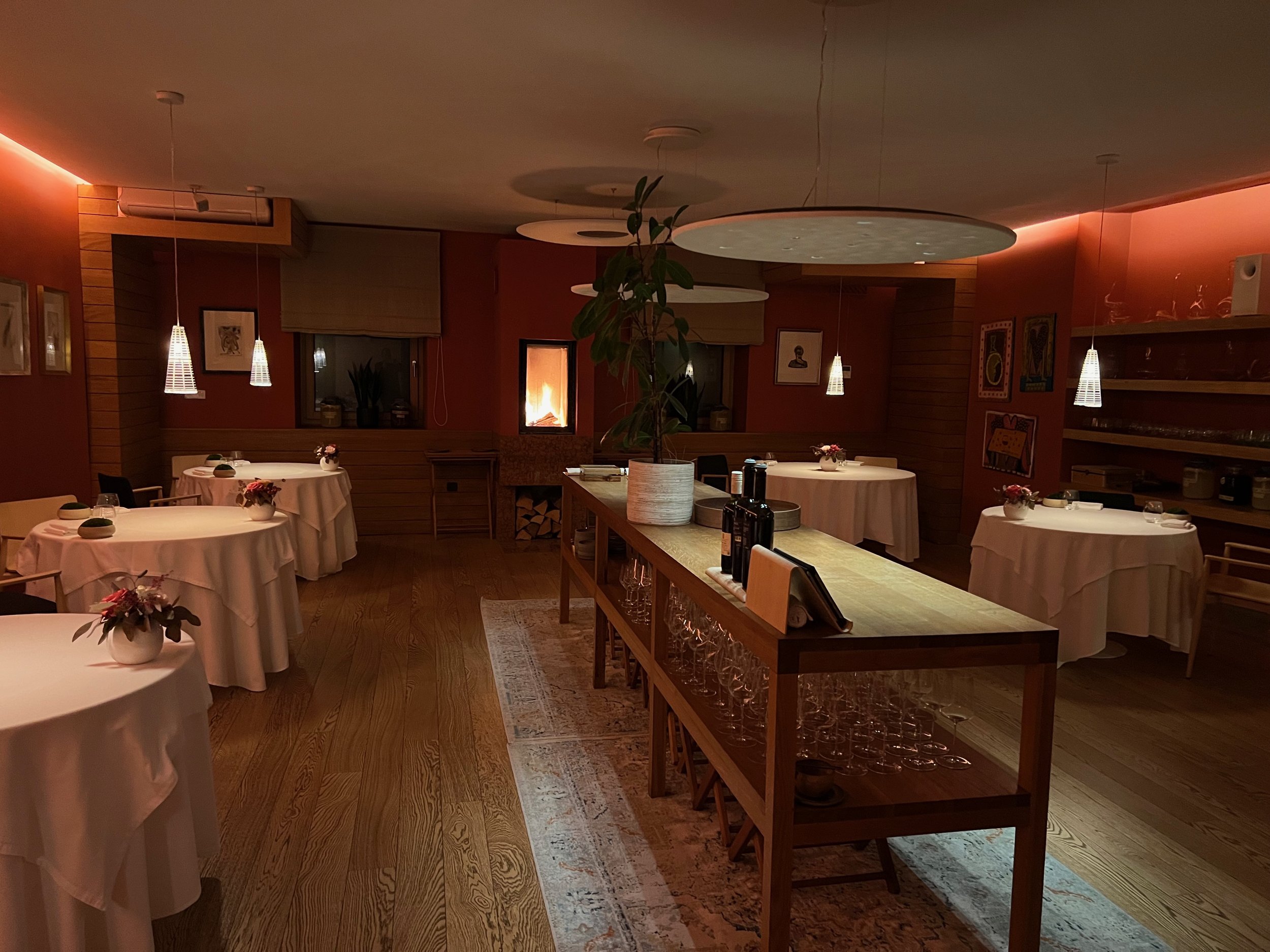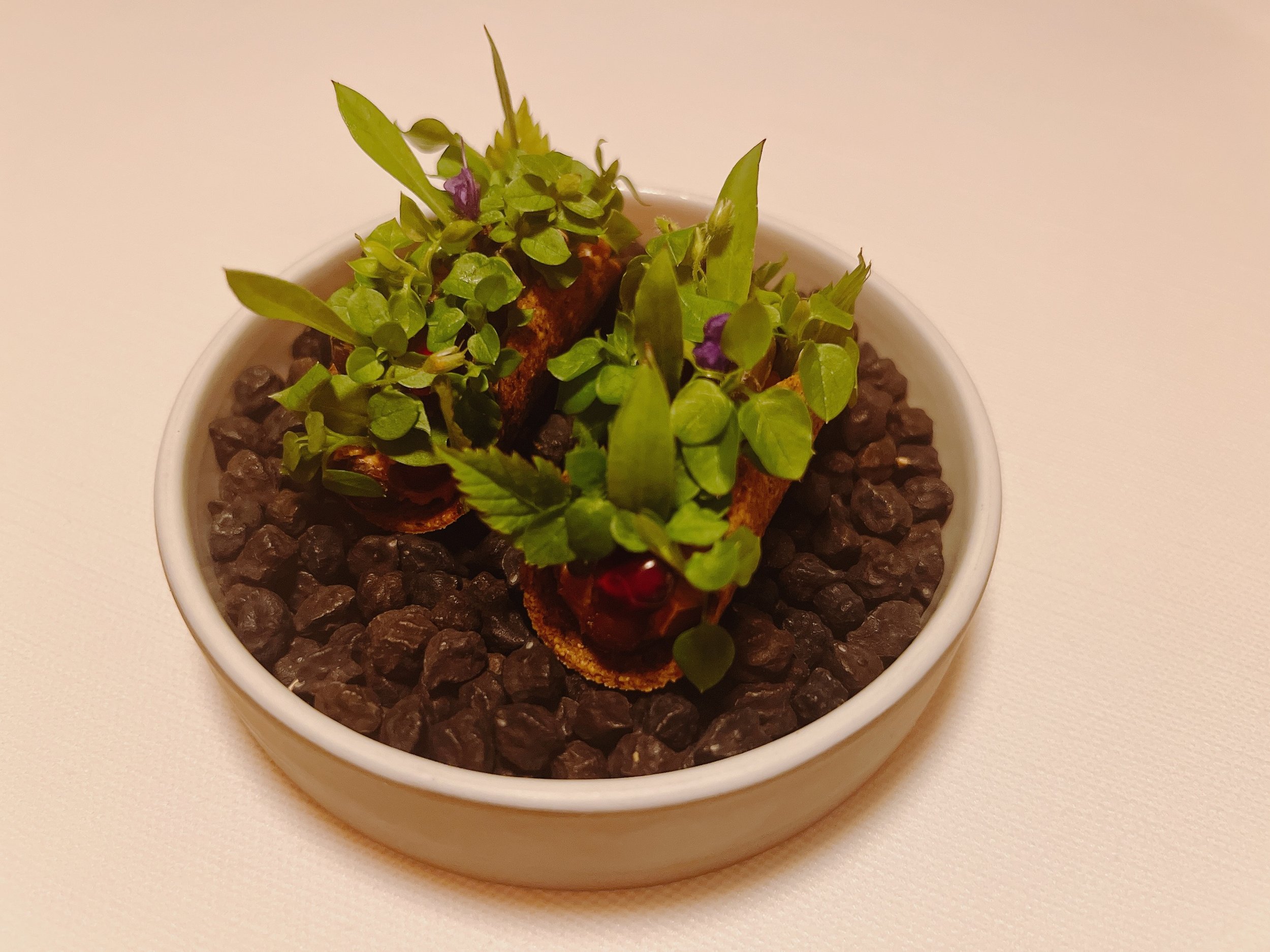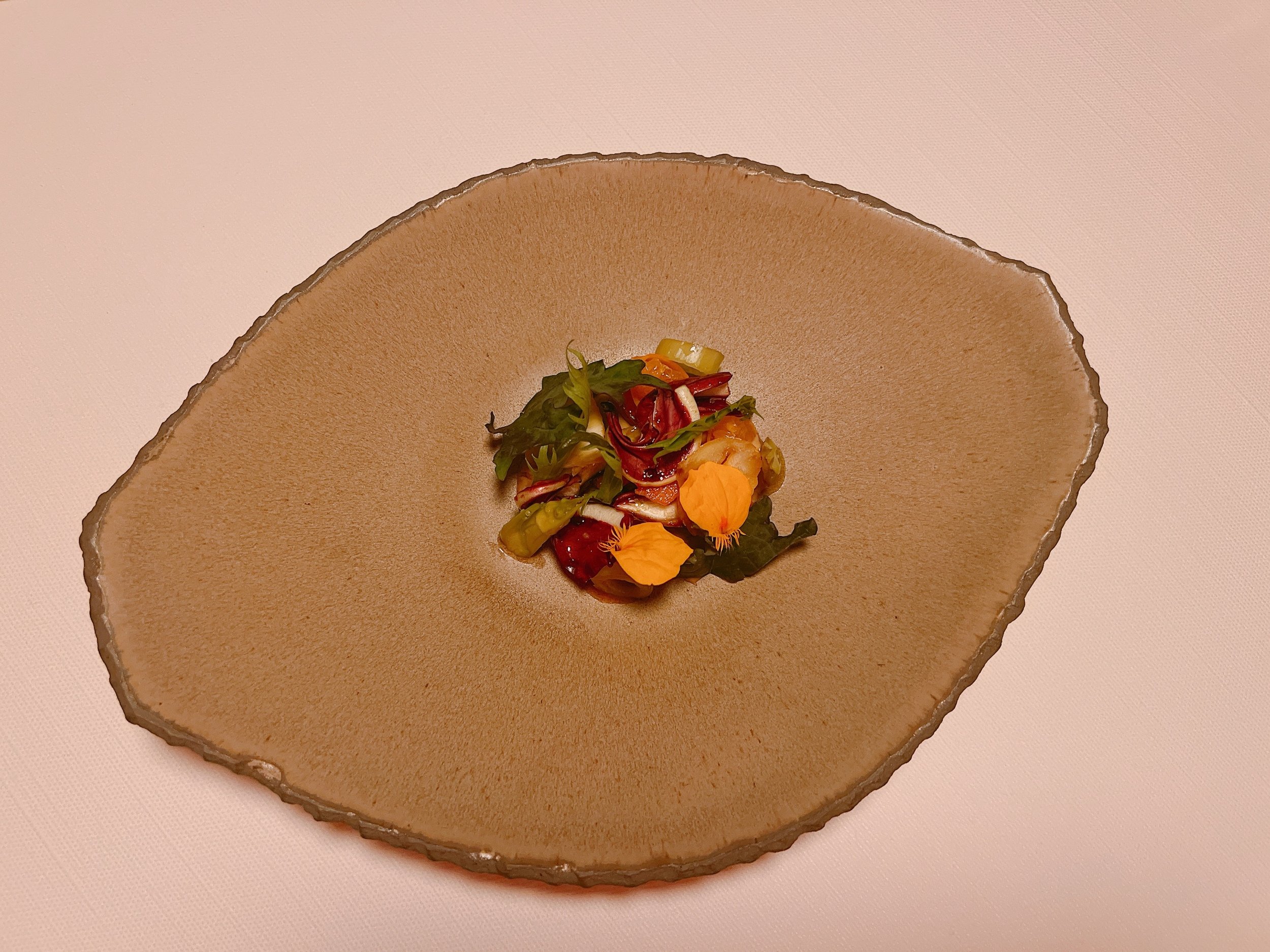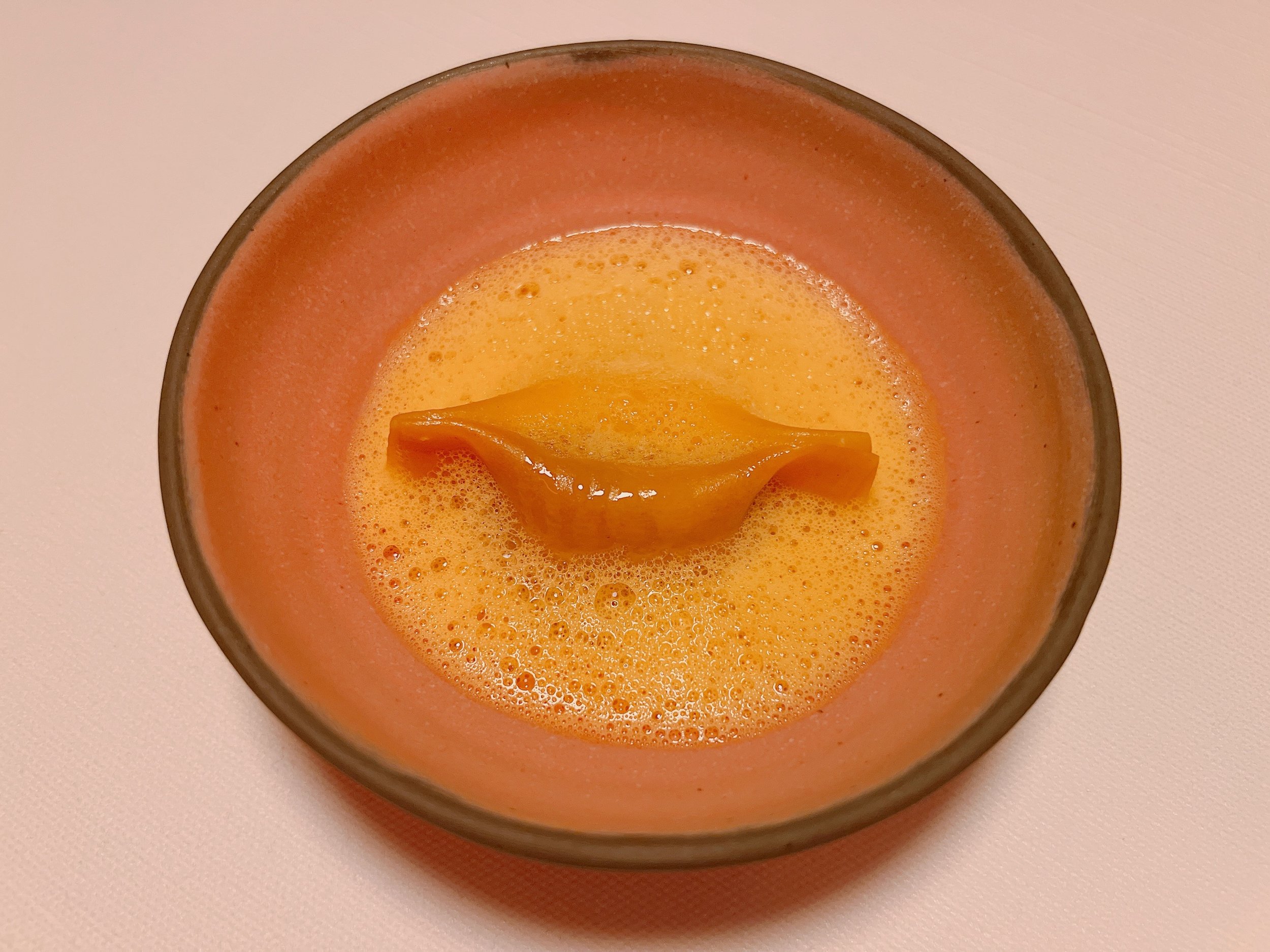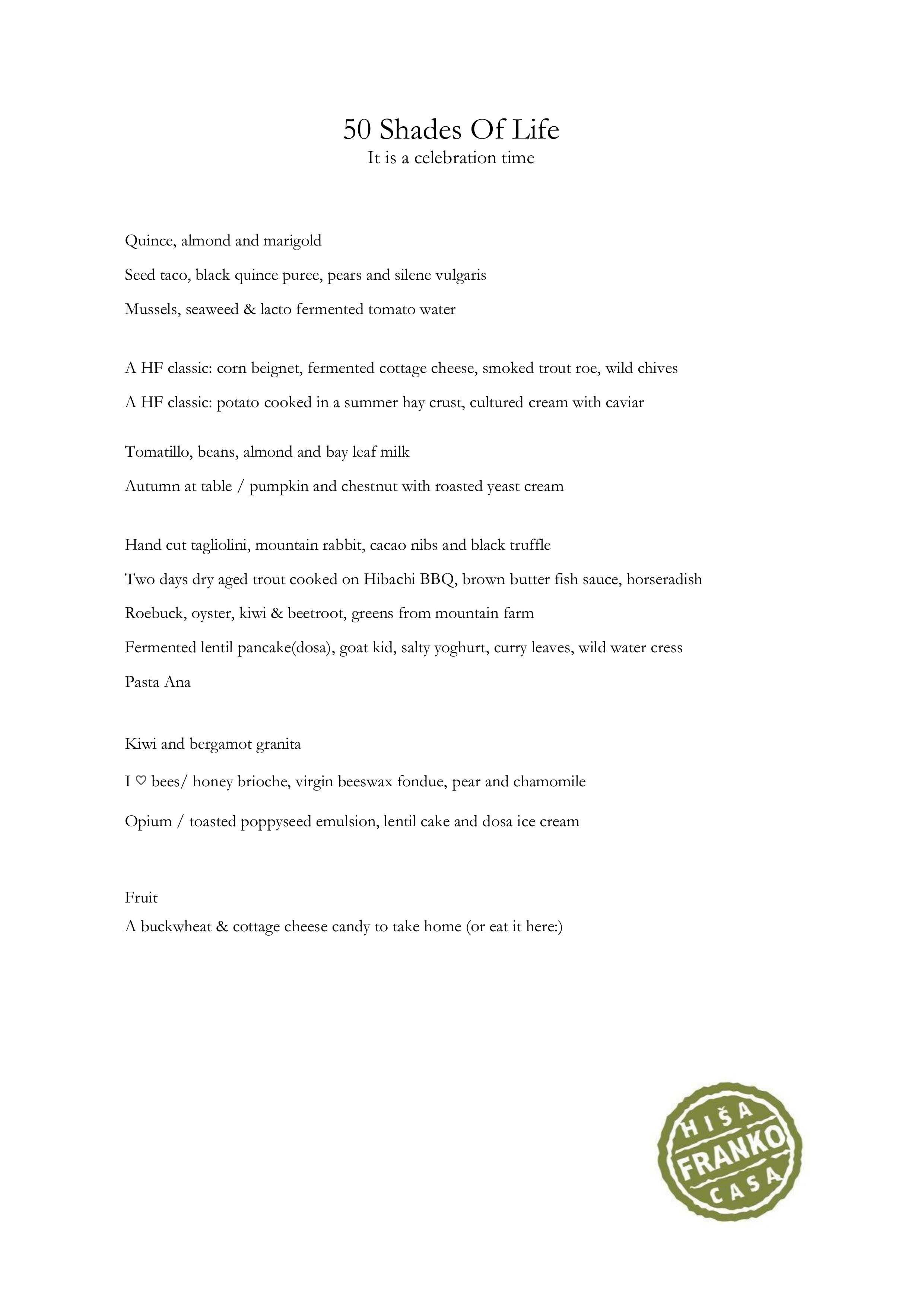Hiša Franko - Kobarid
Rating: 17/20
Where: Kobarid, Slovenia
When: Dinner for 2 on 19 November 2023
Cost per Person: Tasting menu 255 Euro, Wine pairing 150-165 Euro
Accolades: 3 Michelin Stars, #32 on Top 50 Restaurants list (2023)
Why: Delicious seasonal cuisine with ingredients and most wines from Slovenia
The restaurant “Hiša Franko” has long been considered one of the best dining venues in Slovenia. Run by Chef Ana Roš since 2002, it has held two Michelin stars since the first Slovenian edition of the Guide, and finally received its third star in 2023, making it the first restaurant with that honor in Eastern Europe.
Hiša Franko is located in the small town of Kobarid, less than ten minutes from the Italian border. For many travelers, it might be faster to fly to Italy (Venice or Trieste) rather than to Slovenia, and drive to the restaurant from there - which is exactly what we did. Kobarid lies in a deep valley, and the sunlight faded well before sunset. In mid-November it was also pretty chilly - outdoor tables that were used for aperitifs in the summer were the sole domain of desperate smokers. Upstairs from the restaurant a few bed-and-breakfast rooms allowed diners to avoid the tipsy drive home on winding country roads. The rooms were furnished simply but comfortably. Breakfast is included with the rooms, but we sadly missed it due to an early departure.
Entering the restaurant, we arrived at a small bar where aperitifs could be enjoyed before dinner. Most of the cocktails used local ingredients, for example a “mojito” contained cucumber and dill instead of mint. The cocktails weren't bad, but even better were the crackers that came with them. They had been made from the bread that was left over after breakfast. Savory with light spices and a perfect crunch, these crackers would probably rate a 20 had they been part of the tasting menu.
After the cocktails, we were led into one of the dining rooms; ours was the “original” dining room, in use since the property opened as a trattoria about 50 years ago. A fireplace provided warmth at one end of the room, while windows faced the patio on the other side. White tablecloths looked a bit formal, but the unusual red-colored walls suggested a more rustic and homey feeling. Two sets of guests had brought their dogs with them, another sign that the restaurant was not very stuffy. The servers, all dressed in colored shirts, were similarly professional but unfussy. Perfect English was spoken by everyone.
The restaurant served a single tasting menu that changed with the seasons and used ingredients primarily from the local area. There was an option to add an (all-Slovenian) cheese course. But besides that, the only choices were regarding drinks. Two wine pairings were offered: a “classy” and a “funky” pairing, both priced at 150 Euro, and both consisting of seven glasses, most of them spanning several courses. An optional additional glass could be added for 15 Euro more. Finally, there was a juice pairing for 100 Euro. We tried both wine pairings, and strongly preferred the classy pairing. The funky pairing (for better or worse) lived up to its name by offering wines that were on the vinegary, sour side. Drinkable? Sure, but they were also somewhat of an acquired taste. In contrast, the classy pairing consisted of more traditional wines. I liked that most of them hailed from Slovenia or from just across the border in Italy, but was a bit disappointed in the overall quality. They were fine with the food, surely, but (apart from the dessert wine served with the cheese course), not something that I'd buy separately. Still, part of the charm of dining at Hiša Franko is the immersion into Slovenian culinary culture, so the pairing is definitely worthwhile in that regard. However, the additional glass for 15 Euro - a very dry wine, reminiscent of a sherry - left me unimpressed.
It's always interesting to see how a tasting menu begins - ideally the beginning sets the tone for the rest of the proceedings. Hiša Franko uses only local and seasonal ingredients, while at the same time evoking Slovenian cuisine and culture. As a quirky demonstration of those concepts, we were presented with a cushion made from real, living moss. It was (thankfully) not meant be eaten, but to wipe/clean one's hands with. In the farm-to-table category this spiritual cousin of a hot towel was a new one to me.
The next serving was decidedly more edible: a slice of compressed quince served with quince juice, an almond cream and marigold leaves. The almond cream was shaped like an almond, and quite solid - not what you'd expect after hearing the word “cream”. Also confounding expectations, the whole dish was savory, and not sweet (as one might expect after hearing “quince”). A taste of almond with a hint of fruit - a nice beginning 18.
Next, a “seed taco”. A taco shell was filled with pumpkin, chickpeas, a cream of sunflower seeds, black quince, caramelized pears, pomegranate seeds and silene vulgaris, a Mediterranean herb. The taco itself had a light crunch, somewhere between a hard and a soft taco. While there was a hint of fruit, the creamy, crunchy ingredients reminded me more of a seeded bread topped with a creamy spread like cream cheese. A nice way to evoke a traditional dish 17.
A mussel arrived in its shell along with celery, fennel, a nori emulsion and lacto-fermented tomato water. There was a hint of chili in the tomato water, giving it a slightly spicy, refreshing taste. The overall impression was primarily of a herbal dish, the mussel taste was not very strong 17.
Two classics of the restaurant were up next. First, a beignet made from fried corn flour. It was filled with fermented ricotta cheese, wild chives and trout roe. At first glance, this bun’s texture seemed similar to a German Berliner pastry, or what an American would call a jelly-filled donut. However, the filling here was not only savory, and also very tasty - seasoned just right, with good roe and an herbal cream. It was kind of an inverted version a classic appetizer: a slice of bread topped with cream cheese and trout roe. If I had to nitpick, then I’d argue that the beignet seemed a bit too fatty and heavy, but otherwise this was a great dish 18.
Our next course was something that one wouldn't necessarily expect at a three-starred restaurant: a baked potato. It came with some sour cream seasoned with lovage oil and topped with caviar from Austria. That might sound a bit fancier than your run-of-the-mill baked potato's accompaniments, but the caviar was so light in taste that it still left us with essentially potatoes and sour cream - hardly a dish worthy of three stars. What considerably elevated the dish was something else: the preparation of the potato - it had been baked inside a hay crust. Besides hay, the crust also contained egg yolks and salt, and together they created a thick, brown, crunchy layer around the potato. While the crust didn't impart much flavor to the potato itself, it turned out to be edible. And it was a game-changing addition to this dish: lots of salt and the smell and indescribable (unless you're a horse) flavor of hay took this from a simple to an astounding preparation. Justifiably a restaurant classic that manages to evoke the smell of the fields, while being delicious at the same time 18.
Tomatoes came with a bean salad, pickled radish, oxalis, watercress, and a cream made from almond milk and sheep's milk. A fresh, light, and tomatoey dish reminiscent of a walk through a vegetable garden 17.
Next, a representation of autumn. Pumpkin was served three ways: compressed, as a juice and as a fermented cream. Chestnuts were present both as a cream as well as raw. All of this was topped with multiple herbs and flowers, and paired with a cream of toasted yeast on the side. Altogether, this was a really nice salad combining different textures and flavors: crunchy, mealy, fresh, with a touch of fruit, saltiness and some umami from the yeast 18.
Fresh-made tagliolini were combined with a sauce made from rabbit, long pepper powder, green juniper, cheese, carrots, cocoa nibs, tarragon oil and topped with freshly grated black truffles. The pasta was nicely al dente, but the strongest taste here came from the sauce: with some bitterness and taste of umami, it made this an earthy dish. Good, but with less distinct flavors compared to previous dishes 16.
After the pasta came a risotto. Well, sort of - it was actually made from barley, not rice. Other ingredients were green beans, hazelnuts, and a powder of yeast garum. This was not a light preparation - the beans did their best to counter the heavier barley and cream, but overall this remained another autumnal dish. It was creamy, nutty from the hazelnuts and even had a hint of bacon aroma (but presumably didn’t contain any). Good, but similar to the pasta, the flavors were a bit muddled 16.
The next dish was better: a trout dry-aged for two days and then cooked on a Hibachi grill. It was served with trout roe, pickled daikon, horseradish shavings, wasabi leaves and a brown butter hollandaise. The different preparations of trout were nice, but they were unfortunately upstaged by the other ingredients, in particular by the creamy and heavy hollandaise. Perfectly on point though was the use of horseradish: noticeable, but not too spicy 17.
Yet another step up: a dish that was meant to honor the chef's father, who is an avid hunter. Roebuck had been seared and then placed on top of a cabbage leaf, a slice of kiwi (!) and an oyster emulsion. Next to it were some game jus and a beetroot that had been brined with peppercorns, lemon-thyme and passion fruit. The beet was quite sour, which was probably meant to balance the heavier meat, but went a bit too far in that regard for my taste. The meat was excellent - very flavorful, with only a hint of gaminess. The jus provided more umami, a bit of sweetness, saltiness and some flavor “heft”. The unusual addition of kiwi added some freshness without overpowering the savory components. An excellent venison dish 18.
Inspired by South Indian cooking, we next received a small dosa. It was filled with lentils and greens, and was placed next to garden greens and a sauce made from fermented goat cheese that was topped with curry powder. Well, this dish might have looked Indian, but it definitely didn't taste that way. I'd describe it as a savory lentil dish - the meaty lentil filling was definitely the dominant flavor. The dosa’s texture made it hard to tear - attempts to eat this with my hands like a traditional dosa were doomed to failure (and some messiness). The dressing reminded me of a light yogurt dressing, not quite raita, but adding some creaminess and lightness to the lentils 16.
Another pasta dish concluded the savory part of our meal. “Pasta Ana”, named after the chef, was an agnolotti with two separate fillings: one made of fermented cottage cheese, the other of tomatoes. It came with a “secret tomato sauce” - the only ingredient that our server would admit to was chilis. The creamy, slightly sour, but overall quite savory sauce was amazing - a perfect tomato sauce (20 by itself). The pasta was unfortunately less successful. Its dough was a bit too thick, and the filling felt somewhat lackluster: the cheese was decent, but the tomato was oddly sour, reminiscent of tomato paste 17.
Our palate cleanser before dessert was a granita made from kiwi and bergamot. Underneath it was some fresh kiwi, buckwheat honey, sour cream, and puffed buckwheat. The granita felt quite cold after the previous warm(er) courses, and also quite acidic - but maybe that's exactly what you want in a palate cleanser. The other ingredients were a nice complement to the acidity: I liked the the honey's sweetness and the crunchiness of the buckwheat 17.
According to our server, Slovenia is known for two products: milk and honey. The next course incorporated both: a honey bread brioche filled with cheese fondue. It was served with roasted hazelnuts, some fruit, and a cup of tea made from linden leaf, chamomile, ginger and cinnamon. The brioche was fine, with the fruit lightening up an otherwise heavy dish, but in total this wasn't a particularly exciting preparation. The tea was quite sweet, and - surprisingly - also a bit salty 15. The optional wine paired with this course (a Gravner) was on the dry/sherry side, and, to me at least, unmemorable. Which was surprising given the effort that went into its presentation, including a specially made glass. Much better was the cocktail that came with the funky pairing for the following course: it was made from brandy, oolong tea and an apple cider reduction.
More recycling: similar to the bread crackers that had been made from leftover breakfast bread, we now received a dosa ice cream that was made from the cutoffs of the previously seen dosa. The ice cream rested on top of a lentil financier and pieces of quince, and was surrounded by a toasted poppy-seed emulsion finished with olive oil. This was an amazing dessert - the ice cream was particularly delicious, with a flavor that my dining companion described as a mix of walnuts and coffee - very unique. Add to that a nice financier and a sweetness balanced by the tartness of the quince and the saltiness of the poppy-seed emulsion, and we had a clear winner 19.
Next came a piece of persimmon dressed with chili, caramelized grapefruit and lemon. More spicy than fruity, it was a decent palate cleanser 15.
Concluding our dinner was the optional cheese course. All cheeses came from Slovenia, which by itself is probably enough reason to order this - where else would the traveling gourmand have a chance to try such a spread? Most of the cheeses that had been used in the previous courses made a reappearance. My favorites were a cheese vaguely reminiscent of feta, and another, funky-tasting cheese. The paired dessert wine from nearby Italy was excellent as well.
Finally, a wrapped candy made from cottage cheese and buckwheat. Essentially a chewy caramel with a lightly roasted flavor. Nice 17.
Overall: True seasonal farm-to-table cuisine where all the ingredients had been sourced nearby and even the wine pairing hailed mostly from Slovenia. This was not only a terrific introduction to Slovenia, but also for the most part quite tasty. Also impressive: there was scarcely any repetition among the preparations and ingredients - often a problem when limited to seasonal produce in the colder times of the year. Definitely worth the trip to Slovenia 17.
